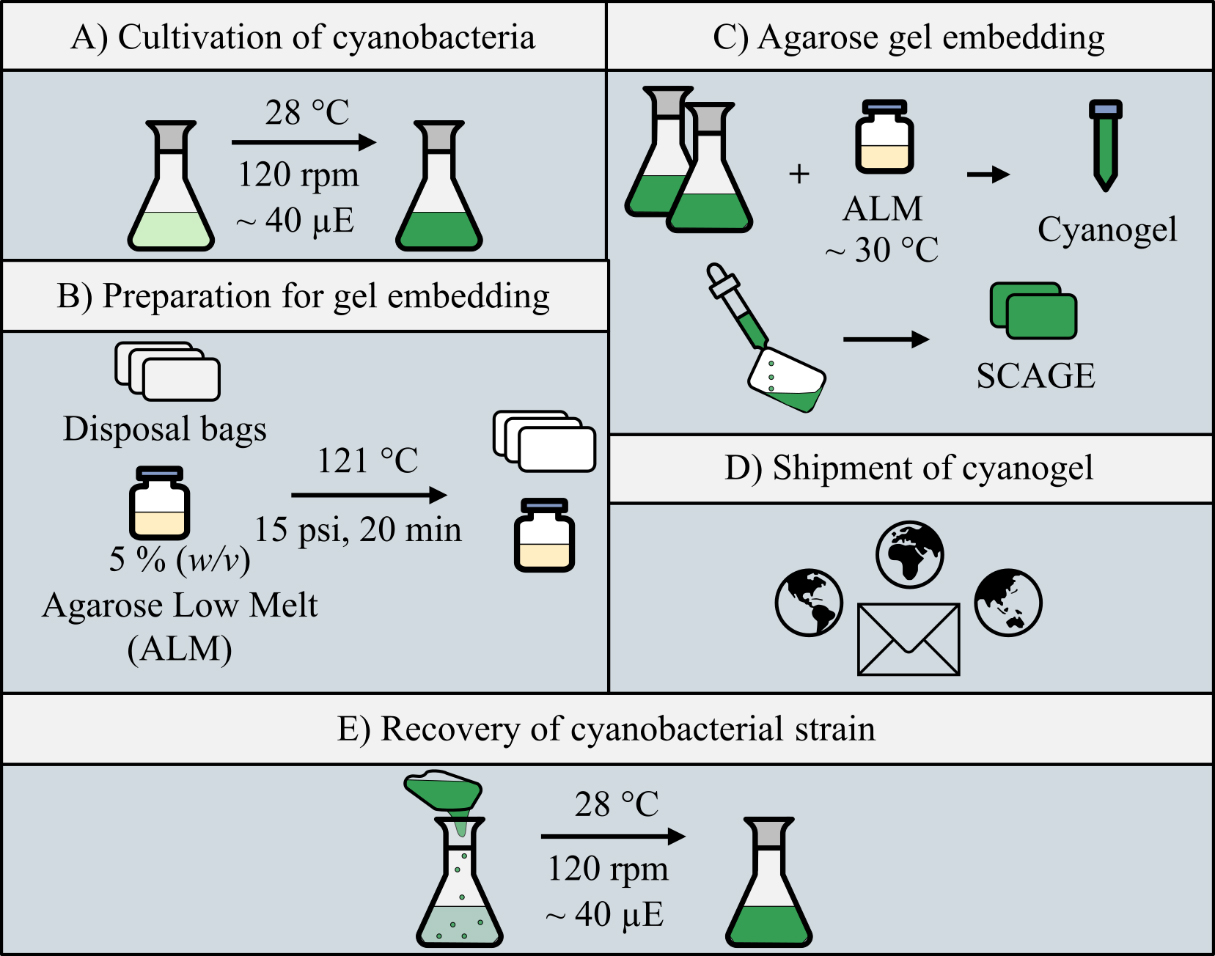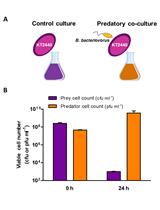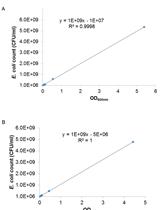- EN - English
- CN - 中文
Shipment of Cyanobacteria by Agarose Gel Embedding (SCAGE)—A Novel Method for Simple and Robust Delivery of Cyanobacteria
藻胶嵌入蓝藻运输(SCAGE)——一种简单可靠的蓝藻递送新方法
发布: 2024年12月05日第14卷第23期 DOI: 10.21769/BioProtoc.5125 浏览次数: 1329
评审: Dennis J NürnbergPatrick Jung
Abstract
In modern science, the exchange of scientific material between different institutions and collaborating working groups constitutes an indispensable endeavor. For this purpose, bacterial strains are frequently shipped to collaborators to advance joint research projects. Bacterial strains are usually safely shipped as cultures on solid medium, whereas the shipment of liquid cultures requires specific safety measures due to the risk of leakage. Cyanobacterial cultures are frequently maintained as liquid stock cultures, and this problem typically arises. This protocol describes a new method for the shipment of liquid cyanobacterial stock cultures by agarose gel embedding (SCAGE). More specifically, a cyanobacterial culture is mixed with low-melting agarose and cast into sterile plastic bags, resulting in a thin, solid cyanobacterial agarose gel (cyanogel) that can be easily shipped. After delivery, subsequent regeneration of the cyanogel material in liquid media results in full recovery of the examined bacterial strains. Thus, the packaging method devised in the present study comprises an innovative technique to facilitate the shipment of bacterial strains, whilst eliminating previously encountered issues like cell culture leakage.
Key features
• New packaging procedure to reduce culture leakage.
• Novel technique facilitating improved shipment conditions.
• Validated method leading to recovery of tested bacterial strains after 14 days.
Keywords: Synechocystis sp. PCC6803 GT (拟鱼腥藻 PCC6803)Graphical overview

Schematic representation of steps for gel embedding and recovery of cyanobacteria
Background
Cyanobacteria are photoautotrophic microorganisms that constitute one of the biggest, most diverse genera of prokaryotes [1]. Among their many characteristics, their ability to produce oxygen and fixate carbon dioxide (CO2) has piqued the interest of scientists worldwide. In recent years, a critical need for a sustainable, CO2-neutral production platform of biofuels and chemicals has emerged and, hence, the investigation of cyanobacterial cell factories has exponentially gained significance [2–4]. Further research on these promising applications of cyanobacteria is necessary and will efficiently accelerate through collaborations between the scientific community.
The exchange of cyanobacterial strains between laboratories is a common procedure to advance joint research projects. Traditionally, bacterial strains are shipped on solid agar plates, in liquid cultures, or cryopreserved and shipped on dry ice. Solid agar plates are effective at preventing leakage but are prone to desiccation, particularly during prolonged shipment. Liquid cultures are suitable for short-term transport but require more complex packaging to prevent leakage. Prolonged shipment under the abovementioned conditions increases the risk of loss of viability of cyanobacterial cells. Cryopreservation is widely used for the long-term preservation of eukaryotic cell lines [5], bacteria, and cyanobacteria [6]; however, shipping cryopreserved samples requires specialized equipment and incurs high costs. Additionally, the shipment of samples on dry ice is prohibited in more than 50% of countries worldwide [7]. Moreover, depending on the cyanobacterial strain, the “reawakening” process can take up to 30 days [6].
Herein, we describe a shipment method for cyanobacteria that increases shipment safety and maintains cells for prolonged times in a viable state by embedding the bacterial strain in an agarose matrix (shipment of cyanobacteria by agarose gel embedding, SCAGE). This agarose gel (cyanogel) is inherently unlikely to display leakage due to the solid state of the material. Moreover, the risk of bacterial desiccation or damage to bacterial vials is greatly reduced due to the embedment in a sterile sealed bag. The casting of thin cyanogels allows for low-cost, efficient shipment in padded envelopes. Furthermore, cyanobacterial cells remain viable and can be successfully recovered after 14 days. A recent study also demonstrated the effective transportation of eukaryotic cell lines using agarose gel-based preservation [8]. This protocol highlights the casting of cyanogels and the subsequent recovery procedure for cyanobacteria.
Materials and reagents
Biological materials
Synechocystis sp. PCC6803, glucose-tolerant (GT) [9]
Anabaena (Nostoc) sp. PCC7120 [10]
Reagents
NaNO3 (Sigma-Aldrich, CAS: 7631-99-4)
K2HPO4 (water-free) (Sigma-Aldrich, CAS: 7758-11-4)
MgSO4·7H2O (AppliChem, CAS: 10034-99-8)
CaCl2·2H2O (Merck, CAS: 10035-04-8)
Na2-EDTA·2H2O (Merck, CAS: 6381-92-6)
Na2CO3 (Merck, CAS: 497-19-8)
Fe(III)-citrate (Sigma-Aldrich, CAS: 3522-50-7)
Citric acid (Roth, CAS: 77-92-9)
H3BO3 (Merck, CAS: 10043-35-3)
MnCl2·4H2O (Roth, CAS: 13446-34-9)
ZnSO4·7H2O (Fluka, CAS: 7758-99-8)
Na2MoO4·2H2O (Sigma-Aldrich, CAS: 10102-40-6)
CuSO4·5H2O (Fluka, CAS: 7758-99-8)
Co(NO3)2·6H2O (Sigma-Aldrich, CAS: 10026-22-9)
NaHCO3 (Fisher Chemica, CAS: 144-55-8)
Agarose low melt (Roth, CAS: 39346-81-1)
Solutions
BG11 medium (see Recipes)
5% (w/v) agarose low melting (ALM) solution (see Recipes)
Recipes
BG11 medium (modified after Rippka et al. [11]):
Prepare 200 mL of each stock solution (1–7) from Table 1, 100 mL of trace element solution (Table 2), and 50 mL of 1 M NaHCO3 solution (Table 3). Use Milli-Q water for each solution.
Stock solutions 1–7 and the trace element solution are sterilized by autoclaving (121 °C, 15 psi, 20 min), while the 1 M NaHCO3 solution is sterilized by filter sterilization (0.22 μm).
Note: Store solutions 1–6 at room temperature and solution 7 [Fe(III)-citrate & citric acid] protected from light at room temperature. Store trace solution at 4 °C and 1 M NaHCO3 at -20 °C.
To prepare 1 L of BG11 (1×), add 5 mL of each stock solution 1–7 (200×), 1 mL of the trace element solution (1,000×), and up to 995 mL of Milli-Q water. Sterilize by autoclaving (121 °C, 15 psi, 20 min). Add 5 mL of 1 M NaHCO3 solution before use.
Note: For the modified BG11 medium, conduct the following adjustments:
Na2CO3: 0.04 g/L (originally 0.02 g/L).
Ferric ammonium citrate was replaced by Fe(III)-citrate.
Table 1. Stock solutions (200×) for BG11 medium
Solution Chemical Molar mass M (g/mol) Molarity c (mM) in 200× stock solution Mass concentration β (g/L) in 200× stock solution Molarity c (mM) 1× medium Mass concentration β (g/L) in 1× medium Mass m (g) in 200 mL stock solution 1 NaNO3 84.99 35230 300 17.65 1.5 60 2 K2HPO4 (water-free) 174.18 35.9 6.25 0.18 0.03125 1.25 3 MgSO4·7H2O 246.48 60.9 14.8 0.3 0.075 3 4 CaCl2 ·2H2O 147.02 49.0 7.2 0.24 0.036 1.44 5 Na2-EDTA·2H2O 372.24 0.5 0.2 0.003 0.001 0.04 6 Na2CO3 105.99 75.5 8 0.38 0.04 1.6 7 Fe(III)-citrate 244.94 4.9 1.2 0.024 0.006 0.24 8 Citric acid 192.13 6.2 1.2 0.031 0.006 0.24 Table 2. Trace element solution (1,000×) for BG11 medium
Chemical Molar mass M (g/mol) Molarity c (mM) in 1,000× stock solution Mass concentration β (g/L) in 1,000× stock solution Molarity c (μM) 1× medium Mass m (mg) in 100 mL stock solution H3BO3 61.83 46.26 2.86 46.26 286 MnCl2·4H2O 197.91 9.15 1.81 9.15 181 ZnSO4·7H2O 287.54 0.77 0.222 0.77 22.2 Na2MoO4·2H2O 241.95 1.61 0.39 1.61 39 CuSO4·5H2O 249.68 0.32 0.079 0.32 7.9 Co(NO3)2·6H2O 291.03 0.17 0.0494 0.17 4.9 Table 3. 1 M NaHCO3 stock solution for BG11 medium
Chemical Molar mass M (g/mol) Molarity c (mM) Mass concentration β (g/L) in 1 M stock solution Molarity c (mM) 1× medium Mass concentration β (g/L) in 1× medium Mass m (g) in 100 mL stock solution NaHCO3 84.01 1,000 84 5 0.42 8.4 5% (w/v) agarose low melting (ALM) solution
To prepare 100 mL of 5% (w/v) ALM solution, add 5 g of ALM in 100 mL of BG11 medium. Sterilize by autoclaving (121 °C, 15 psi, 20 min). Store at room temperature.
Laboratory supplies
Pipette tips with filter (Mettler Toledo, type RAININ)
Serological pipette, 5 mL (Sarstedt, catalog number: 86.1253.001)
Conical centrifuge tubes, 15 mL (Sarstedt, catalog number: 62.554.502)
Disposal bags (Roth, catalog number: E706.1)
Grease-proof paper Profissimo (DM-Drogerie Markt, catalog number: 470799)
Rubber band “Alco 758” 80 × 4 mm (Lyreco, catalog number: 5.112.077)
Steristopper (VWR, catalog number: HERE1013700)
Plastic cuvettes (Sarstedt, catalog number: 67.742)
Erlenmeyer wide-neck flask DIN ISO 24450, 100 mL (VWR, catalog number: 214-1131)
Laboratory bottle, 1 L (VWR, catalog number: 215-1517P)
Beaker, 800 mL (Roth, catalog number: X694.1)
Aluminum foil (Roth, catalog number: 1399.1)
Sterile indicator strip (Roth, catalog number: XC20.1)
Multimark overhead marker permanent (Faber-Castell, catalog number: 151304)
Equipment
Pipettes (Mettler Toledo, model: Pipet-Lite XLS series)
Pipetboy (VWR, catalog number: 613-4438)
Rotary shaker (GFL, catalog number: GFL-3017)
OSRAM LUMILUM DE LUX Daylight lamp (OSRAM, catalog number: L58W/954)
Biosafety cabinet (Bioquell, model: ABS1500CLS2-MK2)
Microwave (OK, model: OMW 330 D-M)
Centrifuge 5804 R (Eppendorf, catalog number: 5804 R)
Centrifuge rotor S-4-72 (Eppendorf, catalog number: S-4-72)
Photometer (Thermo Scientific, model: Spectronic Helios model δ)
Foil welding apparatus (BOSCH, catalog number: FG16-0717901002)
Procedure
文章信息
稿件历史记录
提交日期: Jul 8, 2024
接收日期: Sep 17, 2024
在线发布日期: Oct 22, 2024
出版日期: Dec 5, 2024
版权信息
© 2024 The Author(s); This is an open access article under the CC BY-NC license (https://creativecommons.org/licenses/by-nc/4.0/).
如何引用
Fink, P., Kwon, J. and Forchhammer, K. (2024). Shipment of Cyanobacteria by Agarose Gel Embedding (SCAGE)—A Novel Method for Simple and Robust Delivery of Cyanobacteria. Bio-protocol 14(23): e5125. DOI: 10.21769/BioProtoc.5125.
分类
微生物学 > 微生物细胞生物学 > 细胞活力
细胞生物学 > 细胞活力 > 细胞存活
您对这篇实验方法有问题吗?
在此处发布您的问题,我们将邀请本文作者来回答。同时,我们会将您的问题发布到Bio-protocol Exchange,以便寻求社区成员的帮助。
Share
Bluesky
X
Copy link












